Introduction
The tourism sector is one of the most important economic sectors, both for developed countries and developing countries. This sector has features such as globalization of the tourism market, mobility of tourists, and abundance of information. Also, all these features characterize an information society.
Tourism has continuously expanded in conjunction with economic and social changes, including increased national income and leisure time and improved quality of life (Zhu, Lim, Xie, & Wu, 2018).
Tourism is acknowledged to be very information intensive. Tourists need information before going on a trip to help them plan and choose between options, and also increasingly need information during the trip as the trend towards more independent travel increases. But for this, the information must be available and the tourism professionals with the capabilities to solve the problems.
The theory of social networks identifies the role of social relationships in transferring data, directing personal or media power, and supporting attitudinal or behavioral change (Liu, Sidhu, Beacom, & Valente, T.W, 2017). Network studies have become highly important in recent years and now are even more predominate in the fight against the COVID-19 pandemic.
Today people and organizations remain connected and updated through various forms of social networks like Facebook, Twitter, YouTube, LinkedIn, Instagram, etc. Users usually access social networks’ services via web-based technologies on computers, smartphones, tablets, etc. As users engage with these online services, they create highly interactive platforms through which individuals, communities, and organizations can share, co-create, discuss, and modify user-generated content or pre-made content posted online. Networks formed through social media change the way groups of people interact and communicate. They introduce substantial and pervasive changes to communication between organizations, communities, and individuals. Social media thus can be of vital importance for the tourism industry, especially in terms of engagement with the tourists. Social networks have not only created collective knowledge but have also become important information gathering sources for tourists (Bilgihan, Barreda, Okumus, & Nusair, 2016)
This paper will analyze the influence of social networks in the promotion and search for a tourist destination, namely Serra da Estrela, a place of excellence for the practice of winter sports in Portugal.
The Serra da Estrela ski resort is unique in Portugal and consists of a set of infrastructures, allowing an offer based on a very diverse set of products.
Tourism and Social Networks
Tourism has grown, in terms of complexity of demand, trends, supply, industry, management, and planning instruments; its development around tourist products is replaced by a new perspective of valuing the experiences and sensations acquired by tourists in the places they visit. This is a new reality of Tourism, which promotes a new industry, new tourist markets, new forms, and new instruments of management and planning in the tourism sector. Tourism is considered one of the biggest industries in the world. Under its relationship and interconnection with all other sectors of life (economic, social, cultural, environmental, and political), it is difficult to establish a clear and comprehensive definition of the term Tourism. Many studies consider that a universal definition will be almost impossible to achieve and that it would be more realistic to accept multiple definitions for specific purposes (Ramos & Costa, 2017).
Buhalis (2006), when analyzing the future of the tourism industry, in 2006, mentions that its evolution is the result of the evolution of the Consumption concept, and of consumer trends, who are more informed, and seek more sophisticated experiences. This evolution requires the creation of new products and new strategies for tourism management and organization. Evolution is inevitable and influenced by factors external to Tourism and the globalization of the sector. Probably, more than most sectors of activity, the Tourism sector is facing sharp change and at a galloping pace. This change contributes to the creation of a new tourism consumer. This new Tourism consumer is not an apologist for mass tourism, or for massive marketing. In fact, this new tourist is looking for differentiated Tourism, personalized treatment, knowing other ways of life, and experiencing authentic and genuine experiences. It is an informed tourist, in whose life the technologies of information have a full presence. This new tourist knows what he is looking for, and respects the environment and the community (Costa , 2013). Traditional tourism, to survive, must adapt, become better and more competitive, and be prepared for a tourist market that is more volatile.
Since its appearance, the concept of social networks has evolved, and has become a very powerful tool for information and not just for socialization, as it seemed to be its initial objective. Social networks have become the main channel for accessing content on the Internet. Not only do users turn to blogs and social networks to clarify the most diverse doubts, but also to guide themselves in order to assess whether a purchase decision is the right one. Brand publications and positive word-of-mouth are also considered (Dasilva, et al., 2013). Rosa (2010) even states that users can save money and, above all, time when searching online on social networks about products and/or services.
Currently, social networks are very important due to the enormous sharing and creation of opinions. Many users have a large number of “friends” or “followers”, so it is essential to understand the culture of influence and the strength of recommendation that these platforms represent for any business (Hanna, Rohm, & Crittenden, 2011).
Although, apparently, all social networks look the same, this is not the case. Despite sharing a common objective or functionalities, they present different functions, thus providing their users with different possibilities (Kapoor, Tamilmani, & Rana, 2018).
Tuten & Solomon (2018) divide social media into different zones, according to their use: Zone 1: Social Community; Zone 2: Social Publishing; 3rd Zone: Social Entertainment and, finally, Zone 4: Social Commerce (figure 1).
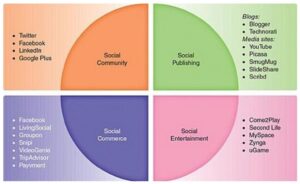
Figure 1 – social media Zones
(source: Tuten & Solomon, 2018)
The use of social networks is seen as an important tool for innovation in tourism. Today, many organizations use social networks to interact directly and dynamically with their customers, challenging the role of intermediaries and shortening the value chain (Lopes, Abrantes, & Kastenholz, 2014).
Tourists, in order to reduce the uncertainty arising from their travel decisions, increasingly collect essential information regarding the trip to be undertaken. Tourists increasingly trust the opinion of other travelers compared to official advertisements and marketing strategies, largely due to the spread and growth of social networks and other user-generated content sites. Many tourists need to get confirmation from other travelers that they are planning the best trip possible. An opinion or recommendation from an acquaintance or friend has a great impact on tourists’ decision-making process (Rathonyi, 2013). Social networks allow consumers/tourists to interact with other consumers in order to share their experiences and also, due to the way they express themselves, it allows them to attract new customers, retain old customers or drive away customers (Yazdanifard & Yee, 2014).
Nowadays, tourists do not book hotels without consulting the opinion of other users who have previously stayed in that hotel. Social networks promote customer loyalty, interaction with customers, and therefore it is important to have a well-crafted page, with strong content sharing (Zeng & Gerritsen, 2014).
The change in tourist behavior is largely driven by social networks, which provide platforms for consumers to connect with tourism businesses, organizations, and other consumers. The explosive growth and popularity of social networks have had a huge impact on the tourism and hospitality industry, so it is consumers themselves who are changing the rules of marketing (Yazdanifard & Yee, 2014).
According to Oliveira (2018), the following opportunities should be considered in the use of Social Networks in the area of tourism:
- New customers: Using new channels different from the usual would increase the probability of reaching new people, thus being able to win new customers;
- Effective communication: Knowing what they say about themselves on Social Networks, and participating in the communication, the company captivates and enhances its relationship with current and potential customers, conveying an image of credibility and trust;
- Word of mouth: The so-called “word of mouth” is a powerful source of dissemination in the tourism area. People who are on travel-related Social Media are eager for relevant and original information. When they obtain it, they easily pass it on to other people, thus obtaining a “viral effect”;
- Online reputation management: By being present on Social Networks and constantly monitoring and controlling them, the company can manage its brand image on them;
- Fun technology: In the field of tourism, you have an excellent opportunity to use all the online tools and applications that can help you create original and fun content (videos, articles, photo albums, discussion groups, online events, contests, etc.) which, in turn, can help attract potential customers;
- Partnering with brands that complete their own services: Depending on the area, making online partnerships with travel agencies, transport companies, restaurants, activity companies, hotels, etc., can complete your presence and offer on Social Networks;
- Publicize a region: Any business in the area of tourism is located in a particular region that people want to visit and get to know, so it is important to arouse the curiosity of the visitor, so that he is not limited to just getting to know your hotel or restaurant. Social Networks should also be used to promote and publicize your region, creating a greater curiosity in the Internet user to visit it.
The Serra da Estrela
Portugal has two large areas demarcated by its geography: the south tends to be flatter, from Ribatejo to the Algarve and the mountainous areas of the North, passing through the islands, the highest point is located on the island of Pico, in the Azores. Madeira Island is highly mountainous. However, it is in the northern part of the country where mountain areas predominate, which are fundamental for its geography and history as well as for the complementary relations of forest-pastoral ways of life, which are established with the valleys, plains, and plateaus (Silva, Abrantes, & Kastenholz, 2018). In Portugal, and according to the same authors, about 40% of the territory has physical and socioeconomic mountain characteristics.
However, altitudes above 700 meters do not reach 12%, with a strong contrast to the north and south of the Tejo river, with 95% of the territory over 400 meters above this river.
The main Portuguese mountains have altitudes around 1500 meters, with the highest value in mainland Portugal being located in Serra da Estrela, with 1993 meters and 2351 in Pico, in the Autonomous Region of the Azores.
The Cordillera Central is the most important mountain system in Portugal, and at its highest point, the Torre, Serra da Estrela reaches an altitude of 1993 meters (figure 2). This mountain thus occupies a prominent position, presenting an unparalleled value in terms of geographic and geological heritage.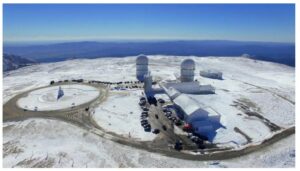
Figure 2 – The highest point in mainland Portugal
(Source: 1001topvideos)
Serra da Estrela extends for about 115 km, from the Guarda region to the Lousã massif, consisting of plateaus elongated in the SW-NE direction. The highest altitudes are located on the Southwest side, on the Planalto da Torre. Gradually, the altitudes decrease until, near Guarda, the mountain almost blends in with the plateaus of Beira Transmontana, meaning that Serra da Estrela is, above all, imposing on its southwest side (Ferreira & Vieira, 1999).
The Serra da Estrela Central Plateau area is classified as a Biogenetic Reserve, comprising an area of 10610 ha, and is part of the European Network, created by the Council of Europe. This protected area represents 12% of the entire Serra da Estrela National Park and is currently included in the Natura 2000 Network.
The Beira Interior region, where Serra da Estrela is located, includes a diversity of differentiating tourist resources that characterize the potential that this region has to be a relevant tourist destination, namely (Silva, Kastenholz, & Abrantes, 2018):
- natural, landscape, and environmental resources;
- traditional culture and customs;
iii. natural, leisure, and sports spaces;
- tourism in rural areas;
- the historical, monumental, cultural heritage;
- the traditional built heritage;
vii. gastronomy and wines;
viii. handicrafts, festivals, fairs, and traditional pilgrimages;
- thermalism;
- winter tourism, with the attractions of snow.
In the specific case of Serra da Estrela, there is no doubt that Environmental Tourism, due to the Serra da Estrela National Park, as well as the region’s flagship product – Snow and Mountain – are the main attraction of the central massif, continuing to be the main focus of Serra da Estrela Tourism, namely with the new equipment for this purpose, and in the Portuguese context, Serra da Estrela is the only national response to this type of demand (Costa, Pereira, & Patudeia, 2012).
Skiing is, therefore, the sport par excellence practiced over the years in Serra da Estrela, and in recent years another sport, snowboarding, has become popular, especially among the younger layers. For the practice of these modalities, there is, in the Tower, the highest point of the entire Serra da Estrela, the Ski Resort of Serra da Estrela, located at 2000 altitude. This resort is equipped with the most recent facilities, housing all the necessary infrastructures for the practice of these modalities, being equipped with modern and sophisticated equipment: such as state-of-the-art mechanical means, a system of identification of ski passes, one of the most modern in Europe and an innovative artificial snow production process that ensures 120 to 150 days of snow per year (figure 3).
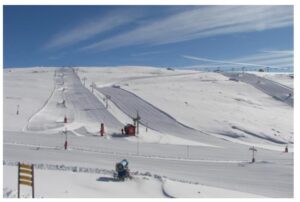
Figure 3: The Serra da Estrela Ski Resort
(Source: skiserradaestrela.com)
Methodology
The main objective of this study is to understand the motivations that lead a tourist to practice winter sports in Serra da Estrela, as well as the influence of the Internet and social networks on the choice of tourist destination. A questionnaire was constructed in order to obtain an answer to these questions. A quantitative methodology was used through a questionnaire survey, with the main methodological elements described in Table 1. The statistical analysis of the data was performed using the statistical software IBM SPSS Statistics, version 26.
Table 1 – Summary of the survey
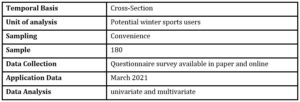
Analysis of Data Obtained
Table 2 summarizes the sample characteristics. The majority of the respondents are women (51.7%), the most represented age group is 25 or less (27.8%), and 51.6% of the sample have basic or secondary education.
Table 2 – Sample socio-demographic characterization
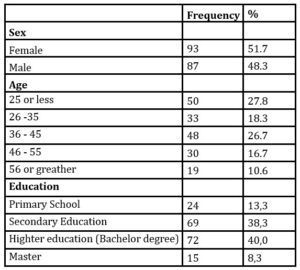
Source: Research Data
Several aspects related to the use of social networks as a search tool for tourist destinations were evaluated (Table 3). The answers were given according to a Likert Scale with the following correspondence: 1. “I completely disagree”; 2. “disagree”; 3. “indifferent”; 4. “I agree”; 5. “I absolutely agree”. In the first stage, reliability analysis was conducted to evaluate the stability and consistency for measured items. The item means and standard deviation ranged between the highest for Internet usage for tourist destinations 4.26±1.13 and the lowest for the promotion of Serra da Estrela on social media 3.26±1.34. The results of this analysis showed the homogeneity of items. In fact, Table 3 shows that all items on the scale had acceptable corrected item-total correlation (0.50 to 0.79). Internal consistency was analyzed, calculating Cronbach’s alpha coefficient for the scale which indicated an overall coefficient r=0.93.
Table 3 – Total reliability analysis of items of Internet and Social networks
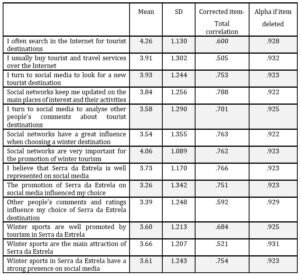
Table 4 shows the results of the principal component analysis, after rotation using the varimax procedure. The Kaiser– Meyer–Olkin measure of sampling adequacy (MSA) was 0.93 and Bartlett’s Test of Sphericity reached statistical significance (chi-squared = 1684.17, df = 78, p < 0.001), supporting the factorability of the correlation matrix. Two factors were found and accounted for 67.3% of the variance (55.5%, and 11.9% respectively). For factor 1 a Cronbach's Alpha coefficient of 0.909 was obtained, and for factor 2 a Cronbach's Alpha coefficient of 0.897.
The first factor entailed seven items all with loadings of at least 0.67. The items included were: searching for tourist destinations on the Internet; purchase of tourist and travel services over the Internet; turn to social media to look for a new tourist destination; Social networks are a source of updates on the main places of interest and their activities; using Social networks to analyze other people’s comments about tourist destinations; Social networks have great influence when choosing a winter destination and Social networks are very important for the promotion of winter tourism. The factor can be termed as “Internet and Social networks”.
The second factor consists of six items with loadings of at least 0.58. The items included were: the Social media representation of Serra da Estrela; the influence of Social media on Serra da Estrela promotion; the influence of social media comments on the choice of Serra da Estrela; the promotion of winter sports through tourism in Serra da Estrela; if winter sports are the main attraction of Serra da Estrela and if Winter sports in Serra da Estrela have a strong presence on Social media. The factor can be termed as “Serra da Estrela and winter sports”.
Table 4 – Principal components solution with varimax rotation
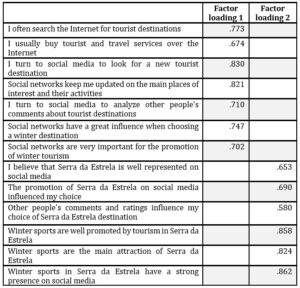 Source: Research data
Source: Research data
The previous two components, together with the age, were then used as clustering variables. First, a hierarchical clustering approach was adopted (Ward method and squared Euclidian distance) to explore cluster patterns and their composition. Three clusters were identified, and subsequently, a non-hierarchical k-means clustering analysis identified the association of the cases to each cluster. Results reveal the existence of three distinct clusters of visitors to Serra da Estrela that
are a little bit different in size, ranging from 31 to 80 members (Table 5). The second cluster is the biggest, accounting for 44.4% of visitors.
The analysis of the clusters’ profiles is presented in Table 5, presenting statistically significant differences between the three clusters in the demographic profile, sources of information about tourism destinations, and Social networks used for the researching of a tourist destination.
Table 5 – Cluster profiles
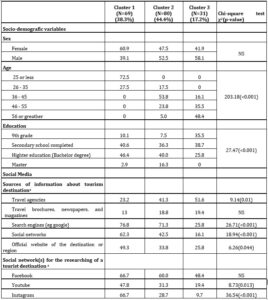
Notes: NS – not significant (p > .05); a- Dichotomic variable – the results represent the answer “Yes”
Cluster one – The first cluster is mainly women (56%) and its members are younger than those of the other clusters (72.5% have 25 or fewer years) and have a higher education degree (46.4%). Relatively to the sources of information about tourism destinations, this cluster gives more importance to search engines (76.8%) and social networks and less to Travel agencies (23.2%) and Travel brochures, newspapers, and magazines (13%). The Social networks used for the research of a tourist destination are Facebook and Instagram.
Cluster two – The second cluster is gender-balanced, the majority are in the age group between 36 and 35 years, and it is the cluster that has the highest number of individuals with higher education (56.3%), particularly a Master’s degree. Relatively to the sources of information about tourism destinations, this cluster gives more
importance to search engines (71.3%) and less to Travel brochures, newspapers, and magazines (18.8%). The Social network used for the research of a tourist destination is Facebook.
The third cluster is mainly men and its members are older than those of the other clusters. Over a quarter possesses higher education and 38.7% have completed secondary school. These tourists use the travel agencies for sourcing information about tourism destinations, and the social network more used for the research of a tourist destination is Facebook (48.4%). These tourists don’t use YouTube or Instagram.
Cluster one is distinguished from the other clusters by choosing the practice of winter sports as the main attraction of Serra da Estrela (see Table 6).
Table 6 – Winter sports like main attraction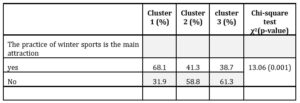
It was then asked who answered that winter sports were not the main attraction of Serra da Estrela, which was the main attraction of Serra da Estrela, and the answers can be found in Figure 4.
The majority of cluster 2 prefers nature and the majority of cluster 3 prefers snow (non-sports related), like cluster 1, which also prefers snow.
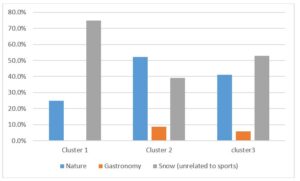
Figure 4 – Preferences of tourists whose main attraction is not winter sports
Discussion and Conclusions
Nowadays the presence of social networks is a reality for the world. These virtual platforms have revolutionized the way we communicate, buy and search for information. Tourism, following the global trends of positioning on social networks, has embraced these tools quite intensely, and today it is almost impossible to promote a tourist destination without using social networks.
This paper aimed to analyze several aspects related to the use of social networks as a tool to search for tourist destinations.
It is concluded that tourists use the Internet to search for tourist destinations and that social networks are an important factor in the promotion of winter sports.
A factor analysis was carried out, and two factors were found that together with age gave rise to three clusters.
The first cluster is mainly women, its members are younger than those of the
other clusters and mostly have a higher education degree. Relatively to the sources of information about tourism destinations, this cluster gives more importance to search engines and social networks. The Social networks used for the search of a tourist destination are Facebook and Instagram.
The second cluster is gender-balanced; the majority are in the age group between 36 and 35 years, and it is the cluster that has the highest number of individuals with higher education, particularly a Master’s degree. Relatively to the sources of information about tourism destinations, this cluster gives more importance to search engines (71.3%), and The Social network used for the research of a tourist destination is Facebook.
The third cluster is mainly men and its members are older than those of the other clusters. These tourists use the travel agencies for sourcing information about tourism destinations, and the social network more used for the research of a tourist destination is Facebook. These tourists don’t use YouTube or Instagram.
Cluster one is distinguished from the other clusters by choosing the practice of winter sports as the main attraction of Serra da Estrela, however, snow and nature are also important factors of the tourist destination Serra da Estrela.
This scientific work, like all scientific work, had limitations. The main limitation of the present study refers to the application of the data collection instrument. In the initial phase of the work, the application of questionnaires to visitors, in person, in Serra da Estrela, was considered. However, due to the covid-19 pandemic, the methodology was readjusted with the implementation of online questionnaires. Data collection in this format conditioned the study sample and probably the information collected.
Acknowledgments
UNIAG, R&D unit funded by the FCT – Portuguese Foundation for the Development of Science and Technology, Ministry of Science, Technology and Higher Education. UIDB/04752/2020.
References
- Bilgihan, A., Barreda, A., Okumus, F., & Nusair, K. (2016). Consumer perception of knowledge-sharing in travel-related Online Social Networks. Tourism Management, 52, 287-296.
- Buhalis, D. (2006). Tourism Business Frontiers – Consumers, products and industry. Elsevier.
- Costa, C. (2013). Turismo nos Países da lusofonia: conhecimento, estratégia e territórios. Portugal: Editora Escolar.
- Costa, I., Pereira, H., & Patudeia, M. (2012). O Marketing Turístico Sustentável orientado para as Comunidades Locais: o Polo de Desenvolvimento Turístico da Serra da Estrela. RT&D, 17/18, 33-44.
- Dasilva, J., Arratibel, A., Aierdi, K., Galdospín, T., Castillo, I., Mardaras, L., & Gonzále, M. (2013). Companies on Facebook and Twitter. Current situation and communication strategies. , 16 (68), 67. Revista Latina de Comunicación Social, 16(68), 676-695.
- Ferreira, N., & Vieira, G. (1999). Guia Geológico e Geomorfológico do Parque Natural da Serra da Estrela. Lisboa: Instituto da Conservação da Natureza.
- Hanna, R., Rohm, A., & Crittenden, V. (2011). We are all connected: The power of the social media ecosystem. Business Horizons, 54, 265-273.
- Kapoor, K., Tamilmani, K., & Rana, N. (2018). Advances in Social Media Research: Past, Present and Future. Information Systems Frontiers, 20, 531-558.
- Liu, W., Sidhu, A., Beacom, A., & Valente, T.W. (2017). Social Network Theory. In ;. Hoboken, NJ, USA: The International Encyclopedia of Media Effects – Wiley Online Library.
- Lopes, R., Abrantes, J., & Kastenholz, E. (2014). Innovation, tourism and social networks. Revista Turismo e Desenvolvimento, 151-154.
- Oliveira, A. (2018). HOSPITALIDADE NAS REDES SOCIAIS: O CCBB BRASÍLIA COMO ANFITRIÃO. CENÁRIO, 6(10), 42-56.
- Ramos, D., & Costa, C. (2017). Turismo: tendências de evolução. Revista Eletrônica de Humanidades do Curso de Ciências Sociais da UNIFAP, 10(1), 21-33.
- Rathonyi, G. (2013). Influence of social media on tourism: Especially among students of the university of debrecen. Appl. Stud. Agribus. Commer., 10, 105-112.
- Rosa, N. (2010). O impacto das redes sociais no marketing: perspectiva portuguesa. Universidade Técnica de Lisboa. Instituto Superior de Economia e Gestão: Dissertação de Mestrado.
- Silva, C., Kastenholz, E., & Abrantes, J. (2018). A IMAGEM DA SERRA DA ESTRELA, NA PERSPETIVA DOS TURISTAS. In Turismo no Centro de Portugal – Potencialidades e Tendências (pp. 279-298). Coimbra: Actual.
- Silva, C., Abrantes, J., & Kastenholz, E. (2018). A Imagem da Serra da Estrela, na Perspetiva dos Turistas. Turismo no Centro de Portugal: Potencialidades e Tendências, 279-298.
- Tuten, T., & Solomon, M. (2018). Social media marketing. Londres: Sage.
- Yazdanifard, R., & Yee, L. (2014). Impact of Social Networking Sites on Hospitality and Tourism Industries. Global Journal of HUMAN-SOCIAL SCIENCE, 14(8).
- Zeng, B., & Gerritsen, R. (2014). What do we know about social media in tourism? A review. Tourism Management Perspectives, 10, 27-36.
- Zhu, L., Lim, C., Xie, W., & Wu, Y. (2018). Modelling tourist flow association for tourism demand forecasting. Curr. Current Issues in Tourism, 21(8), 902-916.












